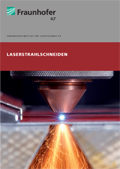A reliable and efficient cutting process requires adaptation of the laser beam and gas jet to the cutting task. We develop and optimize the tools needed for this. The processing heads are designed to achieve the best possible optical imaging properties, cutting gas flow, thermal and mechanical stability, functionality and flexibility.
Using theoretical flow models and Schlieren diagnostics of the gas flow in the kerf, the design of the nozzle is improved to meet specific criteria. The aim is to make the injection of the cutting gas into the kerf most efficient and the expulsion of material most effective and stable. Thus, the optimization of cutting nozzles contributes significantly to improving cutting quality. Innovative nozzles open the way to new techniques such as combined processing, in which an autonomous nozzle enables one head to be used for cutting and welding.

 Fraunhofer Institute for Laser Technology ILT
Fraunhofer Institute for Laser Technology ILT